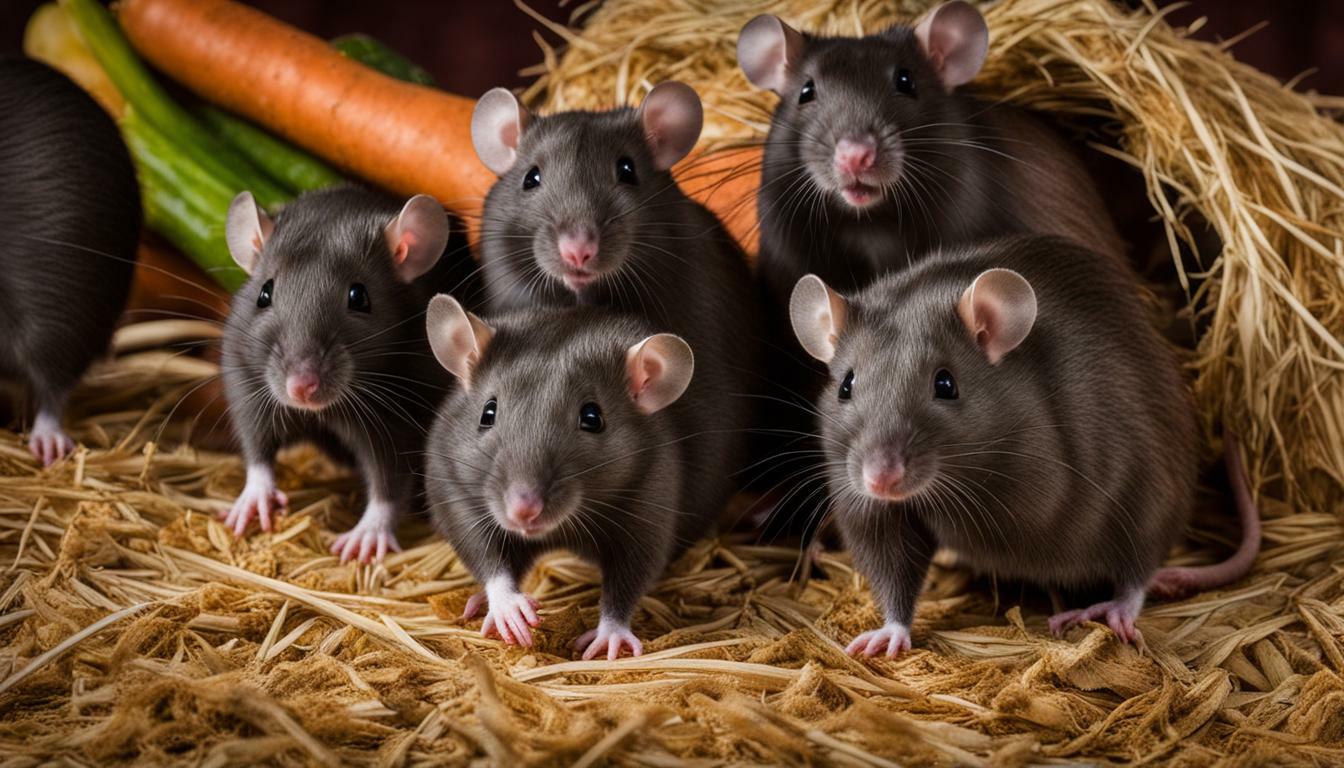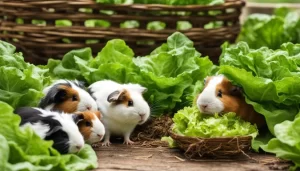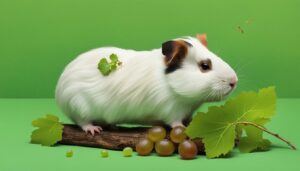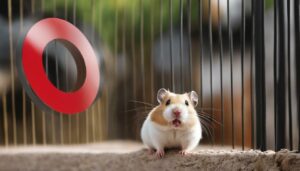If you’re wondering whether rats can eat Timothy Hay, this article will provide insights into their dietary preferences and nutritional needs.
Key Takeaways
- Rats do not require hay as part of their diet, as it does not offer them any significant nutritional value.
- However, some rats may enjoy playing with hay and using it as nesting material.
- If giving hay to rats, it should be done in moderation and specific types, such as oat hay or timothy hay, should be chosen.
- Dust-free and high-quality hay should be selected to avoid potential respiratory issues.
- Hay should only be given in small quantities, mainly for nesting purposes, and should not be the main source of nutrition for rats.
Understanding the Rat Diet
Before we delve into whether rats eat Timothy Hay, let’s take a closer look at their overall diet and nutritional needs. Rats are omnivores, which means they require a balanced diet consisting of both plant and animal-based foods. Their diet should include a combination of high-quality protein sources, such as lean meats or lab blocks, and a variety of fresh fruits, vegetables, and grains. These foods provide essential nutrients like protein, carbohydrates, fats, vitamins, and minerals that are necessary for their growth and well-being.
A staple food in a rat’s diet would typically consist of lab blocks, which are specially formulated to meet their nutritional needs. Lab blocks are fortified with the necessary vitamins and minerals, ensuring that rats receive a balanced diet. Fresh food supplementation is also important to provide variety, as well as additional nutrients that may not be found in lab blocks alone.
“Rats do not need hay as it does not provide any nutritional value for them.”
| Type of Food | Importance |
|---|---|
| Lab Blocks | Provides balanced nutrition |
| Fresh Fruits, Vegetables, and Grains | Provides variety and additional nutrients |
While Timothy Hay is widely used as a dietary staple for other small animals like rabbits or guinea pigs, it does not hold the same nutritional value for rats. Rats have difficulty digesting hay, and it does not provide the necessary nutrients they require. However, some rats may enjoy playing with hay and use it for nesting purposes. If you do choose to give hay to your rats, it should be in moderation and of safe types like oat hay or timothy hay. It is important to select dust-free and high-quality hay to prevent respiratory issues that can affect their health.
Remember, the main source of nutrition for rats should come from lab blocks, supplemented with fresh fruits, vegetables, and grains. Only a handful of hay should be given to rats, mainly for nesting purposes and enrichment. It should not replace their main diet, but rather be seen as an additional source of comfort and stimulation.
The Benefits of Timothy Hay for Rats
While Timothy Hay may not be a necessary part of a rat’s diet, it does offer certain benefits that can support their nutrition and health. Although rats are primarily omnivores that require a balanced diet of proteins, carbohydrates, and fats, introducing Timothy Hay in small amounts can provide additional enrichment and comfort for these curious creatures.
One of the key benefits of Timothy Hay is its fibrous nature. The rough texture of the hay promotes healthy teeth maintenance by providing rats with a natural way to wear down their constantly growing incisors. This can help prevent dental issues such as overgrowth or malocclusion.
Additionally, Timothy Hay can serve as a source of mental stimulation and environmental enrichment. Rats are intelligent animals that require mental and physical stimulation to thrive. By adding Timothy Hay to their habitat, rats can engage in natural behaviors like foraging, burrowing, and nesting. It also provides them with a cozy, safe space to rest and hide, reducing stress and promoting a sense of security.
When choosing Timothy Hay for rats, it is essential to opt for dust-free and high-quality varieties. Dust particles can irritate their sensitive respiratory systems, potentially leading to respiratory issues. Oat hay and timothy hay are generally safe options for rats, as they are less likely to cause digestive problems. Remember to offer only a handful of hay for nesting purposes and not as their primary source of nutrition.
Table: Rat-Friendly Hay Types
| Type of Hay | Safety Level for Rats |
|---|---|
| Oat Hay | Safe |
| Timothy Hay | Safe |
| Alfalfa Hay | Caution (High in calcium) |
| Meadow Hay | Caution (Possible mold) |
In conclusion, while Timothy Hay may not be a vital component of a rat’s diet, it can offer various benefits that support their overall well-being. From dental health to mental stimulation and comfort, rats can enjoy the advantages of Timothy Hay in moderation. Remember to choose safe options, such as oat hay or timothy hay, and provide only small amounts for nesting purposes. By incorporating Timothy Hay thoughtfully, rats can lead enriched and content lives.
Understanding the Role of Timothy Hay in Rat Diets
To determine whether rats can consume Timothy Hay, it’s important to examine the role it plays in their overall diet and the nutritional requirements it fulfills. Rats, being omnivores, have specific dietary needs that should be met to ensure their optimal health and well-being. While Timothy Hay does not provide any significant nutritional value for rats, it can still serve a purpose in their diet.
Timothy Hay can be offered to rats in moderation, primarily for nesting purposes. Some rats may enjoy playing with hay and using it as bedding material, which promotes their natural behaviors and provides them with comfort. When providing hay for rats, it is crucial to choose dust-free and high-quality options to prevent respiratory issues, as rats are prone to respiratory problems. Types of hay such as oat hay or timothy hay are generally safe for rats to consume, but it should be given in small quantities and not be the main source of their nutrition.
“Rats do not need hay for nutritional purposes”
Here is a summarized table of the key points to consider when incorporating Timothy Hay into a rat’s diet:
| Points to Consider | Details |
|---|---|
| Nutritional Value | Timothy Hay does not provide significant nutritional benefits for rats. |
| Types of Hay | Oat hay or timothy hay are safe options for rats. |
| Moderation | Hay should be given in small quantities for nesting purposes. |
| Dust-free and High-quality | Choose hay that is free from dust and of good quality to prevent respiratory issues. |
In conclusion, while Timothy Hay does not provide rats with significant nutritional value, it can still have a place in their diet as nesting material. However, it should only be given in moderation and not be relied upon as the main source of their nutrition. By understanding the role and limitations of Timothy Hay in a rat’s diet, owners can ensure the overall well-being and comfort of their furry companions.
Choosing the Right Timothy Hay for Rats
When offering Timothy Hay to rats, it is crucial to choose the appropriate type that minimizes the risk of respiratory problems and ensures their well-being. While hay does not provide any nutritional value for rats and can be difficult for them to digest, some rats may enjoy using it as nesting material and for playing. If you decide to give hay to your rats, it should only be in moderation and the type of hay selected is important.
Opting for dust-free and high-quality hay is essential to prevent respiratory issues in rats. Dust particles present in low-quality hay can irritate their respiratory system and lead to potential health problems. Therefore, it is recommended to choose hay that has been thoroughly cleaned and processed to remove dust and other allergens.
Oat hay and timothy hay are considered safe for rats to consume, making them suitable choices if you want to provide hay for your furry friends. These types of hay are less likely to cause digestive issues and are generally well-tolerated by rats. However, it is important to note that hay should only be given to rats in small quantities, mainly for nesting purposes, and it should not be their primary source of nutrition.
| Type of Hay | Benefits |
|---|---|
| Oat Hay | Safe for rats to consume and use as nesting material |
| Timothy Hay | Well-tolerated by rats and can be used for nesting purposes |
Remember, hay should always be given to rats in moderation. Too much hay can lead to digestive problems and imbalances in their diet. Rats require a nutritionally balanced diet consisting of high-quality rat pellets, fresh vegetables, fruits, and occasional protein sources. If you have any concerns about your rat’s diet or overall health, consult a veterinarian who specializes in small animal care for personalized advice.
Moderation is Key
While Timothy Hay can be given to rats, it should be provided in moderation and primarily used for nesting purposes rather than as their main food source. Rats do not derive significant nutritional value from hay, and it can be difficult for them to digest. However, some rats may enjoy playing with hay and using it as nesting material, so it can be offered in small quantities.
“Timothy hay is a safe option for rats if given in limited amounts and of appropriate types,” says Dr. Jane Wilson, a veterinarian specializing in small animal care. She recommends selecting dust-free and high-quality hay to minimize the risk of respiratory issues in rats.
When giving hay to rats, choose types such as oat hay or timothy hay, which are safe for consumption. These varieties are less likely to cause digestive problems or allergies in rats. It is important to note that hay should not be the main source of nutrition for rats. Instead, it should be provided as a handful or small portion, mainly for nesting purposes.
| Type of Hay | Safe for Rats |
|---|---|
| Oat Hay | Yes |
| Timothy Hay | Yes |
| Alfalfa Hay | No (unsuitable for rats) |
To ensure the well-being of rats, it is essential to provide a balanced diet that includes other foods rich in nutritional value, such as a commercial rat diet or fresh fruits and vegetables. Rats have specific dietary requirements, and hay alone cannot meet all their nutritional needs.
Rat Diet Guidelines
- Offer a balanced commercial rat diet as the main food source.
- Supplement their diet with fresh fruits, vegetables, and small amounts of protein-rich foods like cooked chicken or eggs.
- Provide a constant supply of fresh water.
- Offer small amounts of Timothy Hay or oat hay for nesting purposes.
By following these guidelines, rat owners can ensure their pets receive the proper nutrition and avoid potential health issues associated with excessive hay consumption or nutritional imbalances in their diet.
Timothy Hay as Nesting Material
In addition to its potential role in a rat’s diet, Timothy Hay can also serve as a suitable nesting material, providing comfort and meeting their innate needs. Rats have a natural instinct to create nests for themselves and their offspring, and hay can be a valuable resource for them in this regard.
When used as nesting material, Timothy Hay can provide rats with a soft and cozy bedding option. Its texture allows rats to create warm and secure nests, mimicking their natural habitat. The hay can also help to regulate their body temperature, keeping them comfortable throughout the day and night.
Furthermore, Timothy Hay can encourage natural behaviors and mental stimulation in rats. It gives them the opportunity to engage in foraging, digging, and rearranging the hay to create their desired nest layout. These activities help to keep their minds active and prevent boredom and stress.
It is important to note that while Timothy Hay can be used for nesting purposes, it should not be the main source of nutrition for rats. Hay does not provide the necessary nutrients that rats require in their diet. Instead, it should be given in moderation, only as a small handful or as an accessory to their regular diet. Dust-free and high-quality options should be chosen to avoid respiratory issues that can arise from dusty or moldy hay.
| Benefits of Timothy Hay as Nesting Material for Rats: |
|---|
| Provides comfort and warmth |
| Meets rats’ innate need for nest building |
| Encourages natural behaviors and mental stimulation |
| Should be given in moderation and as an accessory to regular diet |
Timothy Hay and Rat Health
Incorporating Timothy Hay into a rat’s diet can have positive effects on their health, but it is important to consider its nutritional value and potential impact. Rats do not require hay as a staple food in their diet, as it does not provide significant nutritional benefits. However, some rats may enjoy playing with hay and using it as nesting material.
If you choose to give hay to your rats, it should be in moderation and of safe varieties such as oat hay or timothy hay. These types of hay are less likely to cause digestive issues in rats. Additionally, it is crucial to choose dust-free and high-quality hay to prevent respiratory problems. Dust present in poor-quality hay can irritate a rat’s respiratory system, leading to potential health concerns.
When offering hay to your rats, remember to do so sparingly. Only give them a handful of hay, mainly for nesting purposes. It is essential to understand that hay should not be the primary source of nutrition for rats. Rats have specific dietary requirements, and their main diet should consist of a balanced commercial rat food that provides all the essential nutrients they need.
To provide the best care for your rats, consult with a veterinarian familiar with small animal nutrition. They can guide you on the appropriate diet for your rats and whether incorporating Timothy Hay into their diet is suitable based on their individual health needs.
| Key Points: |
|---|
| Timothy Hay does not provide significant nutritional value for rats |
| Safe varieties, such as oat hay or timothy hay, should be chosen |
| Choose dust-free and high-quality hay to avoid respiratory issues |
| Offer only a handful of hay for nesting purposes, not as a main source of nutrition |
| Consult with a veterinarian for the best diet plan for your rats |
A Comprehensive Rat Feeding Guide
To ensure the best care for your pet rat, this comprehensive feeding guide covers various aspects, including the role of Timothy Hay in their diet and its nutritional benefits.
Understanding the Rat Diet
Rats have specific dietary needs that must be met in order to maintain their health and well-being. A balanced diet for rats typically consists of a mix of commercial rat pellets, fresh fruits and vegetables, and a source of protein. While Timothy Hay does not provide any nutritional value for rats, some may enjoy playing with it and using it as nesting material. It is important to note that rats have difficulty digesting hay, so it should only be given in moderation.
The Benefits of Timothy Hay for Rats
Although rats do not derive any nutritional value from Timothy Hay, it can still offer some benefits. The fibrous texture of hay helps to wear down rats’ continuously growing teeth, preventing dental issues. Additionally, rats may find comfort in using hay as nesting material, as it mimics their natural instincts to build cozy nests for resting and sleeping. However, it is important to remember that hay should not be their main source of nutrition and should only be given in small amounts.
Choosing the Right Timothy Hay for Rats
When selecting Timothy Hay for your rats, it is crucial to choose dust-free and high-quality options. Dust can irritate their respiratory systems, leading to potential health issues. Look for hay specifically made for small animals and avoid hay that is overly dry or has an excessive amount of dust. Oat hay or timothy hay are safe choices for rats, as they are easier for them to chew and digest.
| Type of Hay | Benefits |
|---|---|
| Oat Hay | Easier to chew and digest |
| Timothy Hay | Fibrous texture promotes dental health |
Remember, only a handful of hay should be given to rats, predominantly for nesting purposes. Their main source of nutrition should come from a balanced diet consisting of commercial rat pellets, fresh fruits and vegetables, and a source of protein. Consult with a veterinarian for specific dietary recommendations to meet your rat’s individual needs.
Conclusion
In conclusion, while rats can consume Timothy Hay, it should be given in moderation and primarily used for nesting purposes, as it does not provide significant nutritional value for them. Rats have difficulty digesting hay, and it does not fulfill their dietary requirements. However, some rats may enjoy playing with hay and using it as nesting material.
If you decide to give hay to your rats, it is important to choose the right type. Oat hay or timothy hay are safe options that rats can consume in small quantities. Make sure to select dust-free and high-quality hay to prevent respiratory issues.
Remember that hay should only be given as a handful, mainly for nesting purposes, and should not be the main source of nutrition for your rats. It is crucial to provide a balanced diet that meets their nutritional needs. Consulting a veterinarian or doing further research about rat nutrition can help you ensure the well-being of your furry friends.
FAQ
Do rats need hay as part of their diet?
No, rats do not need hay as it does not provide any nutritional value for them. However, some rats may enjoy playing with hay and using it as nesting material.
Can rats eat Timothy Hay?
Yes, rats can eat Timothy Hay, but it should be given in moderation. Types such as oat hay or timothy hay are safe for rats to consume.
What type of hay should be given to rats?
Dust-free and high-quality hay, such as oat hay or timothy hay, should be chosen to prevent respiratory issues in rats.
How much hay should be given to rats?
Only a handful of hay should be given to rats, mainly for nesting purposes, and it should not be their main source of nutrition.
Can rats use hay as nesting material?
Yes, rats can use hay as nesting material. It can contribute to their comfort and natural behaviors.
What is the nutritional value of hay for rats?
Hay does not provide significant nutritional value for rats. It should be considered more as a nesting material rather than a main source of nutrition.
Is Timothy Hay beneficial for rats?
The benefits of feeding rats Timothy Hay are limited, if any. It is not a staple food for them but can be given in moderation for nesting purposes.
How do I choose the right Timothy Hay for my rats?
When selecting Timothy Hay for rats, it is important to choose dust-free and high-quality options to avoid potential respiratory issues.
What is the role of Timothy Hay in a rat’s diet?
Timothy Hay can be used as nesting material for rats and does not play a significant role in their overall diet. It should be given in small quantities for nesting purposes only.
Can Timothy Hay have any impact on rat health?
Timothy Hay does not have a significant impact on rat health, but it can provide some nutritional benefits and contribute to their overall well-being when given in moderation.




